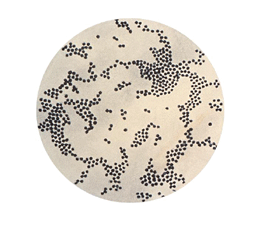| x | x | |||||
| Contact us | Today is | |||||
|
Bacteria, along with blue-green algae, are prokaryotic cells. That is, in contrast to eukaryotic cells, they have no nucleus; rather the genetic material is restricted to an area of the cytoplasm called the nucleoid. Prokaryotic cells also do not have cytoplasmic compartment such as mitochondria and lysosomes that are found in eukaryotes. However, a structure that is found in prokaryotes but not in eukaryotic animal cells is the cell wall which allows bacteria to resist osmotic stress. These cell walls differ in complexity and bacteria are usually divided into two major groups, the gram-positive and gram-negative organisms, which reflect their cell wall structure. The possession of this cell wall, which is not a constituent of animal cells, gives rise to the different antibiotic sensitivities of prokaryotic and eukaryotic cells. Prokaryotes and eukaryotes also differ in some important metabolic pathways, particularly in their energy metabolism and many bacterial species can adopt an anaerobic existence. In this section, we shall look at the structure of typical bacterial cells and the ways in which they liberate energy from complex organic molecules. Various aspects of bacterial structure and metabolism are the basis of bacterial identification and taxonomy. Bacteria are constantly accumulating mutational changes and their environment imposes a strong selective pressure on them. Thus, they constantly and rapidly evolve. In addition, they exchange genetic information, usually between members of the same species but occasionally between members of different species. We shall see how this occurs. Bacteria have parasites, the viruses called bacteriophages which are obligate intracellular parasites that multiply inside bacteria by making use of some or all of the host biosynthetic machinery. Eventually, these lyze the infected bacterial cell liberating new infection phage particles. The interrelationships of bacteria and the phages will be investigated. Finally, we shall look at general aspects of bacterial pathogenesis, that is how bacteria damage the host organism, before surveying a variety of human diseases that are caused by bacteria. THE CHAPTER NUMBERS ARE LINKED TO ILLUSTRATED HTML PAGES.
|
||||||
|
Logo image © Jeffrey Nelson, Rush University, Chicago, Illinois and The MicrobeLibrary |
||||||
| Please tell us where you come from or tell a friend about this book here | ||||||
|
CHAPTER ONE
The Bacterial Cell
CHAPTER
TWO |
An introduction to the
structure of the bacterial cell Bacterial identification in the diagnostic laboratory versus taxonomy. Taxonomic characterization of bacteria. Approaches to rapid diagnosis |
|||||
|
CHAPTER
THREE Nutrition, Growth and Energy Metabolism |
Anaerobic and aerobic metabolism. Metabolism of sugars and fatty acids | |||||
|
CHAPTER
FOUR Cell Envelope, spores and Macromolecular Biosynthesis |
Structure and synthesis of the cell walls of gram-positive and gram negative bacteria | |||||
|
Please send comments and
|
CHAPTER
FIVE Antibiotics - Cell Envelope |
The mode of action of beta-lactam antibiotics | ||||
|
CHAPTER
SIX Antibiotics - Protein Synthesis, Nucleic Acid Synthesis and Metabolism |
The mode of action of antibacterial chemotherapeutic agents. Antibiotic susceptibility testing. The mechanisms by which bacteria express resistance to antibiotics | |||||
|
CHAPTER
SEVEN Bacteriophage |
The general composition and structure of bacteriophage. The infectious process and the lytic multiplication cycle. The lysogenic cycle and its regulation |
|||||
|
CHAPTER
EIGHT Exchange of Genetic Information |
The mechanisms of gene transfer in bacteria. The nature of transposable genetic elements and plasmids. The significance of gene transfer, transposable genetic elements and plasmids | |||||
|
CHAPTER
NINE Genetic Regulatory Mechanisms |
The structure and transcription of bacterial genes. The molecular mechanisms that bacteria use to regulate gene activity. Inducible and repressible operons. The molecular mechanisms involved in catabolite repression and attenuation. The ways bacteria regulate enzyme activity | |||||
|
CHAPTER
TEN General Aspects of Bacterial Pathogenesis |
Exotoxins and endotoxins, transmission, adhesion, immunopathology | |||||
|
CHAPTER
ELEVEN Enterobacteriaceae |
Enterobacteriaceae, Vibrio, Campylobacter and Helicobacter | |||||
|
CHAPTER TWELVE Streptococci, groups A, B, D and others Enterococcus faecalis |
Groups A, B and D streptococcus, viridans streptococci. Pathogenesis, diagnosis. Enterococcus faecalis (formerly group D) | |||||
|
CHAPTER THIRTEEN
PART 1 Streptococcus pneumoniae CHAPTER THIRTEEN PART 2 |
Streptococcus and pneumonia Staphylococcus infections, food poisoning, toxic shock, MRSA |
|||||
|
|
CHAPTER FOURTEEN Neisseria and Spirochetes |
Syphilis, Lyme disease, leptospirosis, gonorrhea, meningitis | ||||
|
CHAPTER FIFTEEN Anaerobes and Pseudomonas - Opportunistic Infections |
Clostridia, gas-gangrene, tetanus, botulism, pseudomonads | |||||
|
CHAPTER
SIXTEEN Mycobacteria and Corynebacteria |
Mycobacterial diseases: tuberculois, diphtheria, leprosy | |||||
|
CHAPTER SEVENTEEN Zoonoses |
Listeria, Francisella, Brucella, Erysipelothrix, Bacillus and Yersinia Plague, Anthrax, Brucellosis, Listeriosis and Erysipeloid |
|||||
|
CHAPTER EIGHTEEN Bordetella, Haemophilus and Legionella |
Whooping cough, Hib disease, Legionnaires' disease, | |||||
|
CHAPTER NINETEEN Mycoplasma and Uroplasma
|
The morphological and physiological characteristics of the mycoplasmas. Pathogenesis of mycoplasma infections. Clinical syndromes associated with and the epidemiology, diagnosis and treatment of mycoplasma infections | |||||
|
CHAPTER
TWENTY Chlamydia |
Developmental cycle of chlamydia. Pathogenesis, epidemiology and clinical syndromes associated with chlamydia. | |||||
|
CHAPTER
TWENTY ONE Rickettsia
|
Interactions of the Rickettsia, Ehrlichia, Coxiella and Bartonella with the host cell. Pathogenesis, epidemiology and clinical syndromes associated with Rickettsia, Ehrlichia, Coxiella and Bartonella. Methods for treatment, prevention and control of rickettsial diseases. | |||||
|
|
||||||


